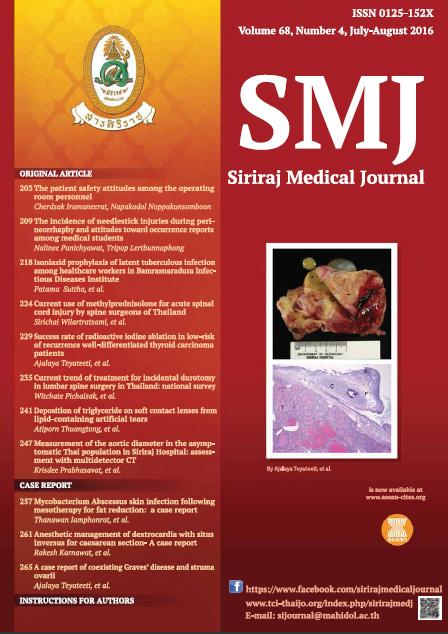Deposition of Triglyceride on Soft Contact Lenses from Lipid-Containing Artificial Tears
Keywords:
Lipid-containing artificial tear, lipid deposition, soft contact lensAbstract
Objective: To determine the amount of triglyceride deposition from a lipid-containing artificial tear eye drop (Endura®) on three different types of contact lenses after one day and one month of simulated use.
Methods: Simulated use of artificial tears was performed in vitro on three different types of contact lenses, including: high water content (HW), low water content (LW), and silicone hydrogel (SI) contact lenses. To simulate one day of use, contact lenses were incubated in artificial tear solution for 16 hours. To simulate a one month of use, they underwent repeated cycles of 16-hour incubation in artificial tear solution, lens cleaning, and 8-hour storage in a multipurpose solution daily for 30 days. Triglyceride deposited was extracted and determined.
Results: After one day of simulated use, amount of deposited triglyceride was significantly different among 3 types of contact lenses with the highest deposition in SI followed by LW and HW contact lenses; the corresponding values (mean ± SD) were 3.79 ± 0.35, 0.84 ± 0.27, and 0.26 ± 0.17 µg/lens, respectively. Only between SI and HW was it found to be statistically different. After one month of simulated use, deposition on SI lenses was slightly increased (6.56 ± 1.10 µg/lens) with that on LW and HW lenses remaining low (0.10 ± 0.12 and 0.55 ± 0.34 µg/lens, respectively).
Conclusion: Triglyceride from lipid-containing artificial tears can absorb into contact lenses, particularly those made of silicone hydrogel, most notably after long periods of use. However, levels of triglyceride deposition are relatively low, when compared to lipid deposition from normal tear films during regular use.
Downloads
Published
How to Cite
Issue
Section
License
Authors who publish with this journal agree to the following conditions:
Copyright Transfer
In submitting a manuscript, the authors acknowledge that the work will become the copyrighted property of Siriraj Medical Journal upon publication.
License
Articles are licensed under a Creative Commons Attribution-NonCommercial-NoDerivatives 4.0 International License (CC BY-NC-ND 4.0). This license allows for the sharing of the work for non-commercial purposes with proper attribution to the authors and the journal. However, it does not permit modifications or the creation of derivative works.
Sharing and Access
Authors are encouraged to share their article on their personal or institutional websites and through other non-commercial platforms. Doing so can increase readership and citations.











